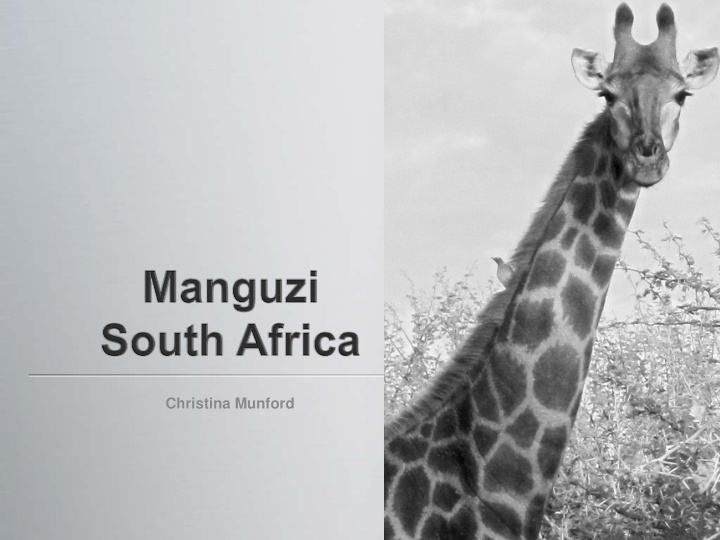



Christina Munford
Manguzi KwaZulu-Natal Province Language: Zulu Area: 2.2 Sq Mi Population: 5,534 Density: 2,500/sq mi One of the most HIV prevalent areas in the world
Founded in 1944 280 beds Majority of physicians there for 1-2 years on required community service Majority of patients are HIV + and many exposed to TB
35 Mobile Sites Physician/nurse visits about once per month 11 Clinics Staffed by nurses Physician visits 1-2 times per month 1 Hospital
Traditional healers Believe that body, mind, spirit & ancestry are connected Believe that sickness is caused by witchcraft or punishment for disrespecting ancestors
There are approximately 200,000 Sangomas while only 25,000 trained doctors in South Africa About 60 - 80% of the population will consult a Sangoma for their primary care Sangomas provide care through a variety of ways Speak to patient’s ancestors for advice and guidance Animal sacrifice Curative medicines called Muthi Cuttings
Muthi may contain: Animal or human products (bones, brains, skin) Plants, bark, herbs Chemicals, oils, minerals Concoctions can cause: Vomiting/diarrhea severe dehydration Hallucinations i l
Sangomas will make multiple incisions on patients skin They will then rub muthi concoctions into the cuts This leads to infection, pain and multiple scars
During my time at Manguzi hospital I saw the many negative effects of Sangoma and muthi: Babies with severe malnutrition secondary to muthi Patients stopping ARVs per advice of the Sangoma Advanced diabetic feet that failed sangoma treatment resulting in amputation
Unfortunately not much. The Sangoma is a very significant part of South African and Zulu culture The hospital must work to educate the community and it’s patients while respecting their beliefs I saw this being done through patient counseling and outreach clinics
Patient : 32 yo M with right hand tendon injury by machete Procedure : Tendon repair under local anesthetic (the patient watched!) A tourniquet was placed on the patients arm and he was given lidocaine boluses for anesthetic The Mistake : nurses removed the tourniquet and all of the lidocaine went to the patients heart at once The patient went from unconscious to seizing to psychosis with severe tachycardia The hospital had no lipophilic agents to bind the lidocaine, thus we had to just wait it out Lesson Learned: Release the anesthetic a little at a time
I was able to assist in a “caesar” (c-section) in the operating theatre (OR) During the case I started hearing singing, I assumed it was a nurse, but when I looked up the patient was singing in Zulu The entire OT filled with both male and female nurses joined in. It was awe-inspiring. Lesson Learned: Culture is beautiful and unique, appreciate every single opportunity you have to be exposed to it.
Pool Time! Our Grocery Store Sundown (sunset) on the Water Tower
Monkeys Elephant Impalas
Baby Sea Turtles Snorkeling! Estuary
http://www.southafrica.net/za/en/articles/entry/article- southafrica.net-traditional-healing1 https://en.wikipedia.org/wiki/Traditional_healers_of_S outh_Africa#Beliefs_and_tradition http://www.capechameleon.co.za/printed-issue/issue- 24/cover-story/ http://www.avertaids.org/avert-south-africa.html
Recommend
More recommend